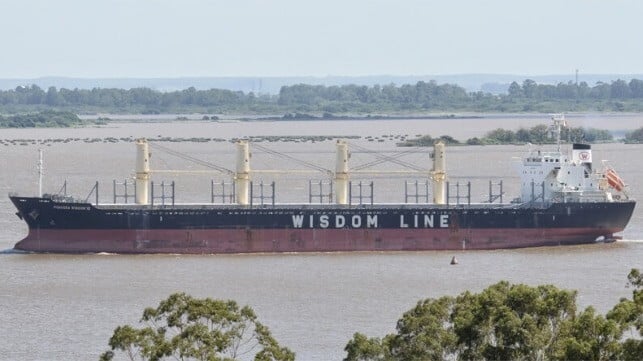Poor Communication Blamed for Bulker Accident in New Zealand

Lack of proper communication caused a crew member to be seriously injured while preparing securing gear to load a cargo of logs on bulk carrier Poavosa Brave outside Tauranga Harbour, New Zealand in June 2023, the New Zealand Transport Accident Investigation Commission (TAIC) determined.
TAIC released its final report on its investigation into the serious injuries that caused the hospitalization of a Chinese seafarer aboard the mid-size handy bulk carrier on June 23, 2023. The investigation established that the accident happened because the people involved didn't know what each other was doing, mainly due to failure to communicate and to follow the operator’s safety management system.
Poavosa Brave is a Panama-registered bulker operated by Wisdom Marine International. The 28,367 dwt bulker built in 2018 by Imabari Shipbuilding Company, Japan, had arrived in Tauranga four days earlier where the crew was required to prepare the vessel for a full cargo consignment of logs. Part of the tasks included using one of the on board cranes to erect sets of collapsible stanchions on the main deck.
At 0700 on June 23, the bosun went to the bridge for a routine morning meeting with the master and the chief officer. The master told the bosun that the weather and sea conditions were not suitable for the crew to use the crane to pull up the collapsible stanchions and that the job could be done after the vessel was alongside the berth.
At 1330, the bosun, three seafarers, and one ordinary seaman went out on deck, to the starboard side of number 5 hatch to pull up the stanchions. The bosun thought that the weather had eased and wanted to take the opportunity to train the crew. The bosun briefed the crew about how the stanchions would be pulled up. After going through the work plan step-by-step, the bosun went up to the driver’s cab to operate the crane.
The investigation established that at 1345, all the stanchions at the starboard side of number 5 hatch were upright and secured. Five minutes later the chief officer, who had heard the crane running, came out on deck to tell the crew to stop the work. However, the stanchions were already upright and secured and the final task was to unhook the stanchion pull wire.
According to the investigation, the bosun’s work plan was for the crew to unhook the pull wire after the crane hook was landed and stable on the deck next to number 5 hatch. However, the bosun mis-landed the hook on top of number 5 hatch. As the bosun started to reposition the hook from the hatch top to the deck, the chief officer told the crew to go up to the hatch top to unhook the pull wire. Critically, there was no communication between the chief officer and the bosun.
As the bosun repositioned the crane hook and as the seafarers began to climb up to the hatch top, the vessel started to roll due to the bad weather, causing the suspended crane block to swing. Two seafarers were able to run away but the third, who had climbed further up the hatch coaming, could not manage. He was struck by the hook, leading to serious injuries. There was no damage to the vessel.

that matters most
Get the latest maritime news delivered to your inbox daily.
“Accidents happen when people don't communicate. In doing unauthorized work and not telling responsible officers, the bosun short-cut the abilities and authorities of the master and the chief officer to assess the safety of planned work,” said TAIC in the report.
The investigation established that it was very unlikely for the accident to have occurred if the bosun had communicated intentions to erect the stanchions to the chief officer and the master because it would have allowed the responsible and authorized officers to either prohibit the work or establish a safe system of work that was known to all relevant participants in the activity.
